Boost IT efficiency with Winget and PowerShell! Learn how to automate app installations, updates, and management seamlessly.
During the last few years, Microsoft has been investing resources into its package manager, winget.exe. Winget is a command-line package manager that allows you to install your favorite applications with a single command. Without getting into an unattractive backstory, you can now manage winget with PowerShell. In this post, I'll show you how to use the Microsoft.Winget.Client module to manage winget with PowerShell on your desktop.
Getting Ready
You will, of course, need to have winget installed on your machine. The application is a Microsoft open-source project. Winget should be part of newer Windows 11 installations. Although, you most likely will need to update it. Run winget -v to check the version you have installed and compare it to the latest stable release on GitHub.
If you don't have it installed, you can download it from the Microsoft Store, the GitHub releases page, or use PowerShell.
You can run these same commands on Windows 11 to upgrade winget to the latest version. The VCLibs and Ui.Xaml packages are dependencies that may not need to be updated. If you get an error that they are already at the latest version, don't worry about it.
For now, winget should be considered an interactive desktop package management tool. You need at least Windows 10 1809. The only server support it has is on Windows Server 2022 and even that is considered experimental.
I recommend you spend some time using the native winget command-line tool. The PowerShell module is a wrapper around the underlying winget APIs and if you don't understand how winget works, you may find the PowerShell module a bit confusing. This advice goes for anything that has a PowerShell management layer. Know how to use native tools before you start using any PowerShell-equivalent commands.
Installing the Module
The PowerShell module for the winget client is also an open-source project. You can find and install the module from the PowerShell Gallery.
If you are new to PowerShell you might be prompted to update the NuGet provider. Go ahead and do that.

Note: The module is supported on Windows PowerShell and PowerShell 7.
Install the Module:
Conceptually, winget is a user-specific tool, so I'll use the CurrentUser scope, but it doesn't make any difference. Again, if you are new to PowerShell answer Yes if prompted to install from an untrusted repository.
Key Module Commands
The module includes many commands.
I'm not going to go through all of them, but I'll show you some of the more useful ones.
One thing to be aware of, at least as of the time I am writing this, is that the module's help documentation is minimal.
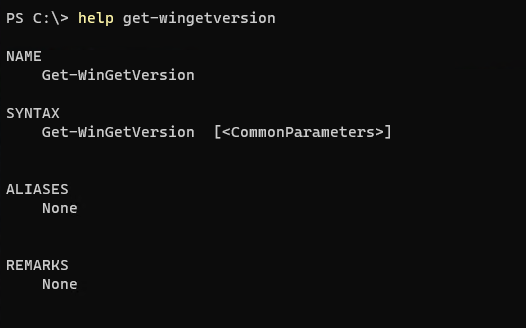
I know the team behind the module is writing cmdlet help which I hope will be part of the next release. At least the command names are meaningful and follow the PowerShell verb-noun naming convention.
Remember, the PowerShell commands are wrappers for the underlying winget command-line tool. The PowerShell module doesn't add any features that you can't do with winget. What you do get are PowerShell features like pipeline support and -WhatIf.
This also means that any shortcomings in the command-line tool will be reflected in the PowerShell module.
Command: Find-WinGetPackage
You can configure winget to use multiple sources, including the Microsoft Store. For the sake of my demonstrations, I'm going to use the default winget source. Use the Find-WinGetPackage command to search for a package. I want to install the latest PowerShell 7 preview. There are several parameters you can use to filter the results such as -Tag or -Id. Or do what I usually do and use a broad name like PowerShell.

From here, I can narrow my search and confirm the package I want to install.
Unlike winget which gives you text, the PowerShell module returns objects with defined properties.
When searching for packages you have to be careful. Even though PowerShell isn't case-sensitive by default, winget can be touchy. Using the native command you might try this:
You don't want the preview version so you try to find it with PowerShell.
This isn't as specific as you might think. You need to include the Equal parameter, as you would in the native command.
Notice that casing matters.
Also, in the world of winget, there is a distinction between the package you install and its manifest. You can learn more about the package from its manifest with the show command.
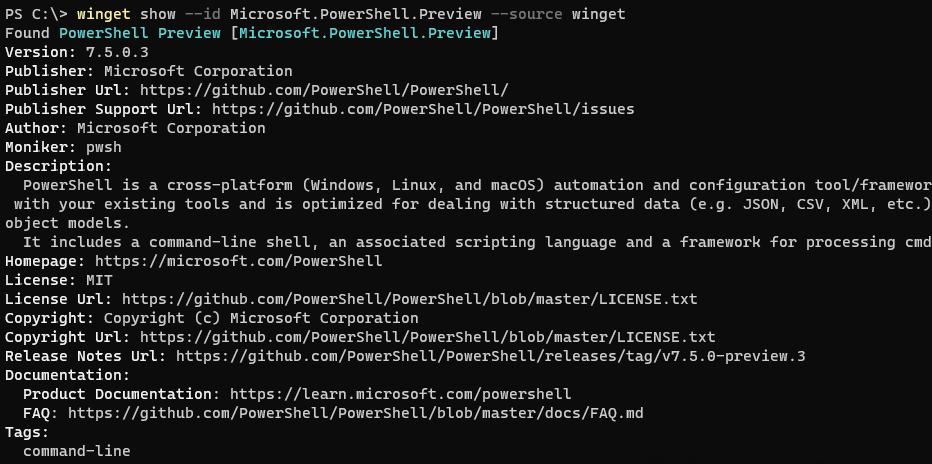
Command: Install-WinGetPackage
Once you've found the package you want, bring the find command back to your prompt and pipe it to Install-WinGetPackage.
I find it best to be as specific as possible when installing. I like using the -Id parameter to specify the package I want to install. This way I can be sure I'm getting the package I want.
Warning
There is one major issue with the Install-WinGetPackage command that has been filed as a GitHub issue. Even though the command says it supports -WhatIf, it doesn't. If I try to run Install-WinGetPackage -Id Dropbox.Dropbox -Source winget -Verbose -WhatIf, the command will install the package. I have to believe this will be fixed in a future release since it is fundamental to the PowerShell paradigm.
Command: Get-WinGetPackage
It is no mystery that Get-WinGetPackage will show you all installed packages. Although by default, the command will also show installed AppX packages like "Phone Link" and "Notepad". Even though there is a -Source parameter, it doesn't seem to work. You can filter the results with Where-Object.
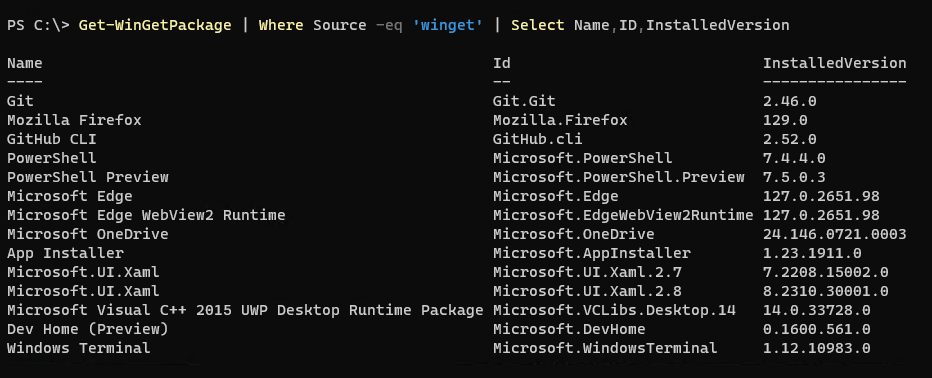
As before, if you want a specific package you need to be careful with the casing.
Command: Update-WinGetPackage
Over time, packages will need to be updated. The output of Get-WinGetPackage has a convenient property you can use.
You can't simply run Update-WinGetPackage and expect it to update everything automatically. You need to be specific.
The package updates should be silent and unattended. At the end of the process, the command will give you a summary result.

Beware
Unfortunately, the Update-WinGetPackage command suffers the same flaw as Install-WingetPackage. The syntax indicates it supports -WhatIf, but it doesn't.
Command: Uninstall-WinGetPackage
To remove a package, use the Uninstall-WinGetPackage command. You can use the Get-WinGetPackage command to find the package you want to remove. As with the other commands, you need to be specific.
If there is an error with the uninstall, you won't get a PowerShell error, you'll get something in one or more of the output errors. PowerShell will give you an exception if the Uninstall-WinGetPackage command fails, such as if it can't find the package.
Scripting WinGet Management
Where this module is worth your time, despite the shortcomings, is in scripting. You can use the module to automate the management of your desktop applications. This is useful when building test systems. Or if you want a way to ensure your desktop is configured the way you need it. It is much easier to script with PowerShell than to use the native winget command-line tool.
Let me give you a few examples. First, I created a JSON file with the packages I want to make sure are installed and up-to-date. Run a command like this to create the file.
Edit the file to include only the packages you want to install. I'm using JSON but you can use whatever format works for you.
I have this script that will read the JSON file and install the packages if not already installed. If the package is installed, then it will check for updates.
My code adds support for WhatIf that works.
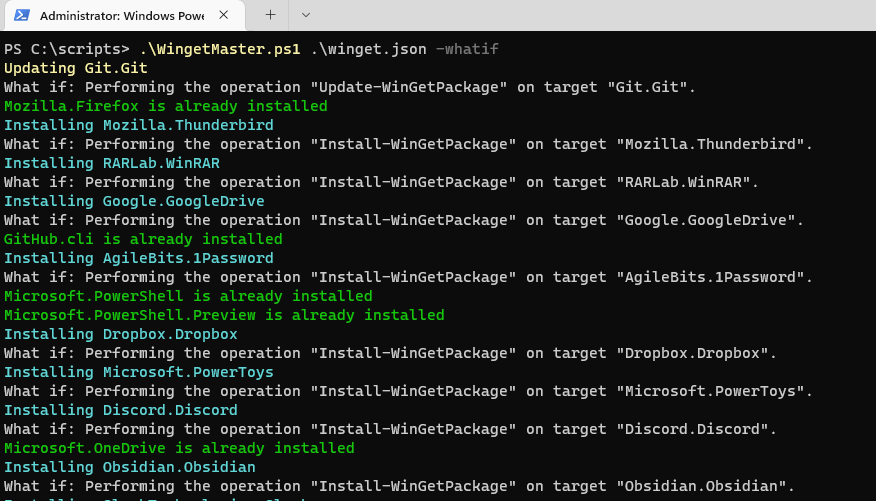
You can run this as often as you like. It won't install anything that is already installed or up-to-date.
I also have a tool I use to update selected packages. This script requires PowerShell 7 and the Microsoft.PowerShell.ConsoleGuiTools module.
I have several packages that either I want to keep at a given version, don't want to update because of compatibility issues, or prefer to manage updates by other means. My script uses an exclude file to define these packages.
When I run the script, packages with available updates are displayed using Out-ConsoleGridView.
I can select the packages I want to update and click OK. The other reason I'm using PowerShell 7 is that I can run the updates in parallel. This is a great way to update multiple packages quickly.
Conclusion
I am hoping for the next release of the Microsoft.Winget.Client module will include more robust help documentation and resolve a few bugs. The module is a great way to automate the management of your desktop applications if you are a winget user. You can use it to ensure your desktop is configured the way you need it or use it to quickly configure lab or test machines. Winget is still primarily a desktop tool. I know there is a Winget DSC resource in the works, that could address server needs, but that's a topic for another post.
I encourage you to try the module and bang on it. File issues and start discussions on the GitHub repository. The more feedback the team gets, the better the module will become and we'll all benefit.
Your ultimate PowerShell Cheat Sheet
Unleash the full potential of PowerShell with our handy poster. Whether you're a beginner or a seasoned pro, this cheat sheet is designed to be your go-to resource for the most important and commonly used cmdlets.The poster is available for download and in paper form.
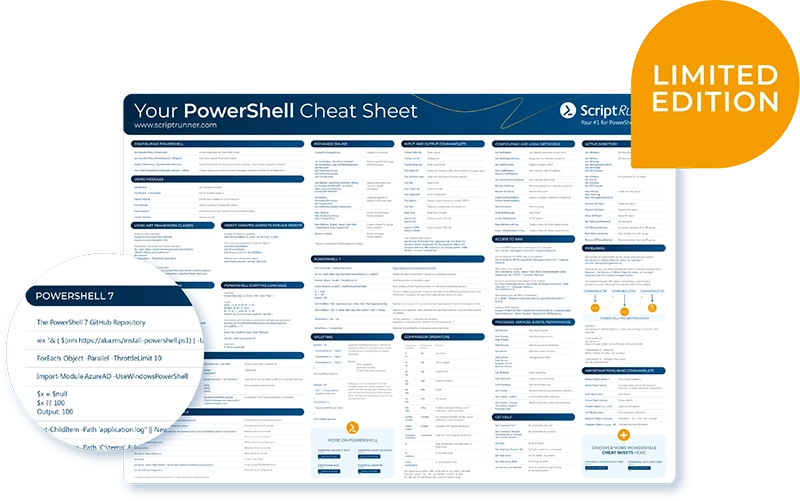
Get your poster here!
Related links
- Winget on GitHub
- The PowerShell module for the winget client is also an open-source project.
- All of our goodies for you on one page: Active Directory, Graph, Teams, Exchange and the general Cheat Sheet and more on Security
- ScriptRunner ActionPacks will help you automate tasks
- Try out ScriptRunner here
- ScriptRunner: Book a demo with our product experts
.svg)
.svg)

